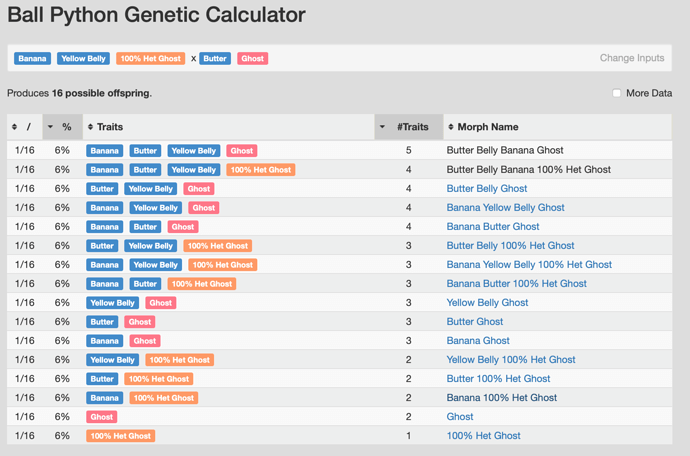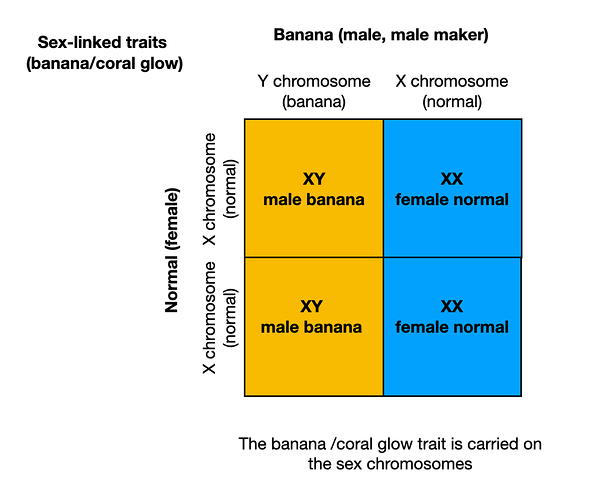So last year I bred my CaramelGlow male to my Butter Ghost female. I bred this pair multiple times. Common denominator here is ghosts and butter ghosts 100% het caramel offspring. She produced 4 eggs: two butter ghosts and two butters…huh? Both animals visually ghost. Looked back in my records and noticed I did a one time pairing with Banana Yellowbelly. So the butter ghosts were males and the butters were females.
Is it safe to say the female butters came from the banana Yellowbelly and the butter ghosts from the CaramelGlow?
Fast forward to this season I find out my Banana Yellowbelly is 100% het Ghost and Pied. NOW… what does that mean for the 2019 clutch. Could all babies be from the banana and if so why wouldn’t all babies be female considering my banana is a male maker?
Strong minds help me with this one
1 Like
Male maker just means that only his male offspring with carry the “banana”, his female offspring will get a normal allele from him. So you will still get an ~50/50 mix of males and females, either which could carry the yellowbelly. All of the other traits assort independently of sex, and so if all males were butter ghosts and the females were just butter, than that’s just random chance
No… if your banana yellowbelly male is 100% het ghost as well, then these offspring could have been produced from either pairing.
Sorry about all the edits, took me a minute to sort out what was going on.
3 Likes
So there is no way to tell if the Butter Ghosts came from the CaramelGlow or the Banana Yellowbelly without breeding?
If your Banana Yellowbelly male is truly het ghost, then no. These are the expected offspring results from both pairings, and as you can see, Butter Ghosts can come from both.
1 Like
That wouldn’t be possible for the male banana to pass on the butter gene since he doesn’t have it. correct me if i am understanding or reading this wrong.
The female would pass it on in both/either pairing
1 Like
ok a few things just to make sure following the story correctly.
2019 carmel glow x butter ghost. 4 eggs produced 2 butter ghosts het carmel albion and 2 butter hets ghost/carmel albino
- one time pairing of banana yb- did you see lock ups? and was pairing before or after carmel albino
How did you find out the banana yb is 100% het ghost and pied?
Yes confirmed 2 day lock up from Banana Yellowbelly that was in between the CaramelGlow breedings in 2019. The Banana Yellowbelly bred to the the same Butter Ghost female this year but he was the sole breeder of her this time and I produced 6 eggs:
Yellowbelly Ghost
Banana Yellowbelly
Butter Ghost
Banana Ghost
Banana Butter
Banana Butter Yellowbelly Ghost
If the CaramelGlow was the sole breeder last year all babies would show ghost but they didn’t so either the clutch was split or they belonged to the Banana and I just didn’t hit the banana gene.
Is it safe to say the female butters came from the banana Yellowbelly and the butter ghosts from the CaramelGlow?
No since your Banana YB is also Het Ghost, getting non banana females is not a guarantee.
While male makers will produce banana and banana combos males while the rest of the clutch will be female it does not always work like that, male makers can produce Banana and Banana combos females while non Banana can be males.
So sex is never a guarantee.
1 Like
That’s what I’m learning right now, the sex is not guaranteed!
So just to make sure I understand this correctly. If a pairing is banana x normal and the banana is a male maker then all the visual banana babies roughly should be male and the non-banana babies are female but can produce males equally, is this accurate?
If not… break it down for me by a clutch of 6 eggs
If the banana “mutation” is on the Y chromosome (which only males have), then that male will only be able to pass on the banana phenotype to his male offspring (because they will automatically get a Y chromosome from him). He is called a “male maker”
If a female ball python has the banana mutation, it will be on an X chromosome, which means she can pass it to either her male or female offspring. Any males she passes it to will have the banana mutation on the X chromosome, and so they will only be able to pass it on to their daughters, and will be a “female maker”.
The rare occasion that a male maker would produce a female banana can only occur if there is a crossover event during meiosis and that gene that carries the banana mutation ends up on the X chromosome instead of the Y.
4 Likes
Male Maker will produce Male Banana and Combos while the rest of the clutch will be female.
Female Maker will produce Female Banana and Combos while the rest of the clutch will be Male.
Females produce a normal sex ration.
Obviously there are exceptions when it comes to male and female makers after hundreds of Banana and CG combo my experience has been text book at about 98% but I know some people that have hatch 1 Banana or CG female from a male maker for example in every clutch.
3 Likes
So here is the thing… I bred my male making male banana Yellowbelly het pied ghost to a normal het pied and produced the following:
Male banana Yellowbelly
Male Banana Yellowbelly Pied
Male NORMAL 66% double het ghost pied
Female pied
Female Yellowbelly pied
Female Yellowbelly
Female Normal 66% double het ghost pied
Key being the 3rf male down I thought was female until hemi penes popped
So clearly you cannot rule out a possibility that the opposite sex of what’s predicted will happen
Correct?
I am not 100% sure what you’re asking, but there is always a slim chance he could produce a female banana through recombination. Unlikely, but potentially possible
It’s never 100% text book
While a male maker will produce male Banana and Banana Combo while the rest of the clutch (non banana) will be female there are exceptions they can produce Female Banana or Banana Combo as well as non Banana Male or Combo.
That’s the answer I was looking for.
I heard 93% against 7% odds.
Thank you everyone I feel I have a better understanding on the gene.
Here’s the paper on the actual genetics of it, they estimated a combined recombination percentage of 6.6%
2 Likes


